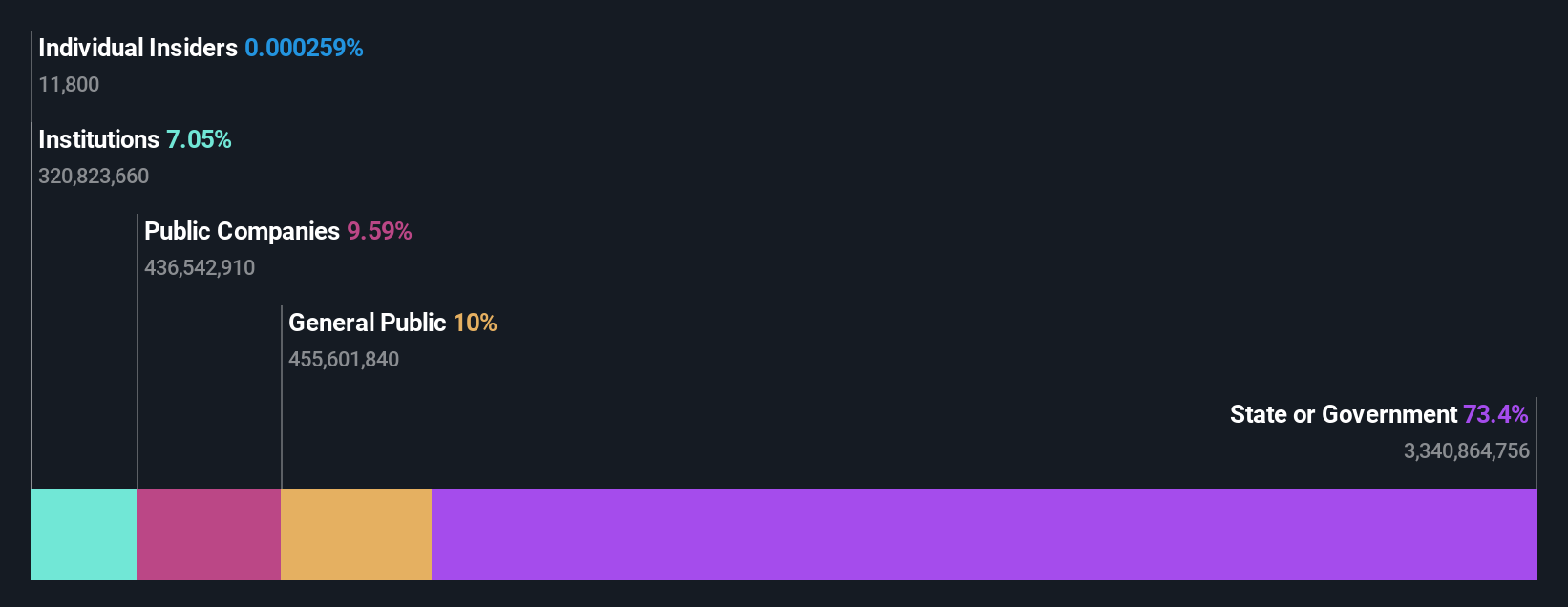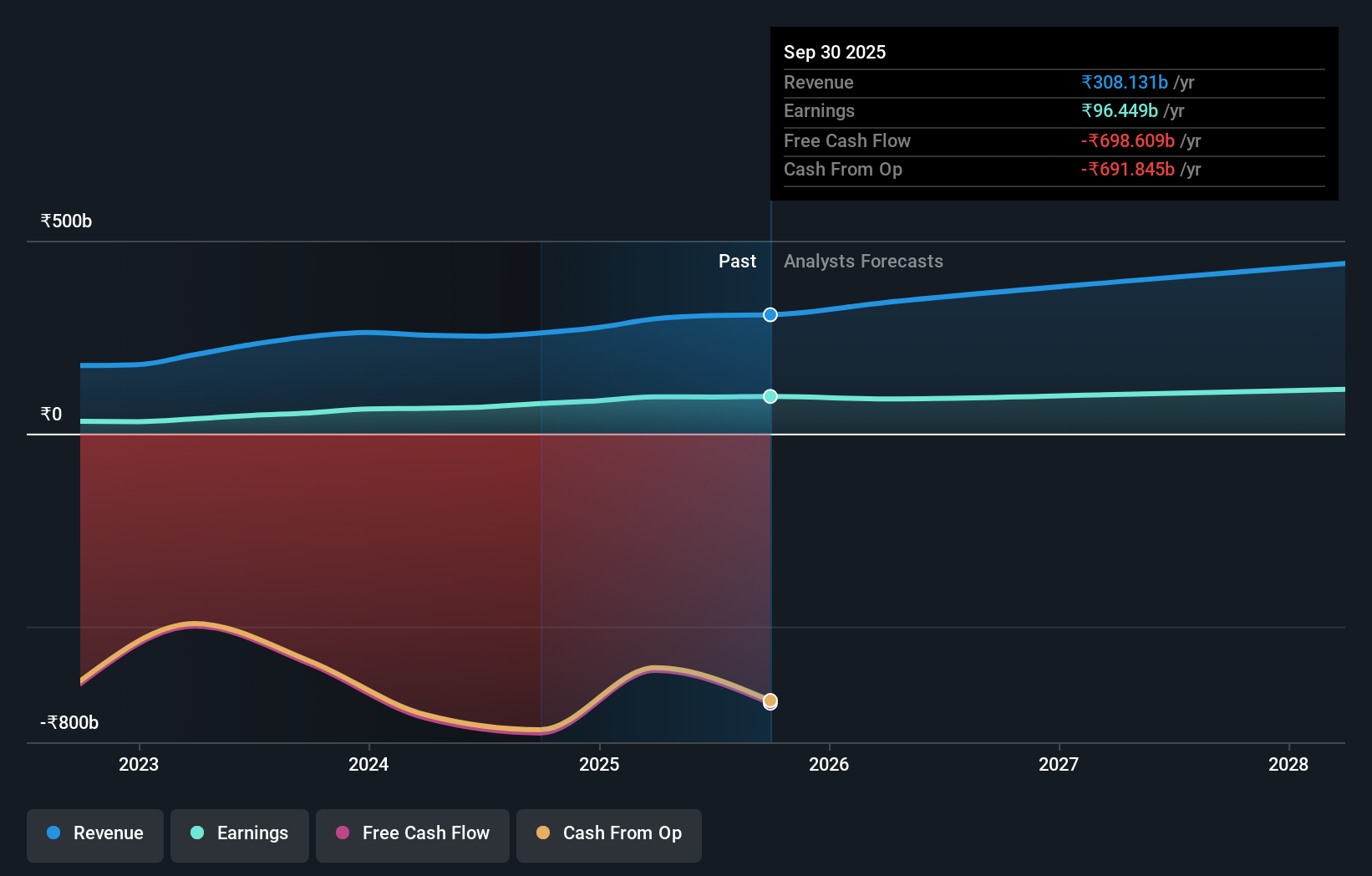Bank of India Limited's (NSE:BANKINDIA) largest shareholders are state or government who were rewarded as market cap surged ₹20b last week
Key Insights
- Bank of India's significant state or government ownership suggests that the key decisions are influenced by shareholders from the larger public
- The largest shareholder of the company is The Republic of India with a 73% stake
- Using data from analyst forecasts alongside ownership research, one can better assess the future performance of a company
A look at the shareholders of Bank of India Limited (NSE:BANKINDIA) can tell us which group is most powerful. The group holding the most number of shares in the company, around 73% to be precise, is state or government. Put another way, the group faces the maximum upside potential (or downside risk).
Clearly, state or government benefitted the most after the company's market cap rose by ₹20b last week.
Let's delve deeper into each type of owner of Bank of India, beginning with the chart below.
See our latest analysis for Bank of India

What Does The Institutional Ownership Tell Us About Bank of India?
Many institutions measure their performance against an index that approximates the local market. So they usually pay more attention to companies that are included in major indices.
Bank of India already has institutions on the share registry. Indeed, they own a respectable stake in the company. This suggests some credibility amongst professional investors. But we can't rely on that fact alone since institutions make bad investments sometimes, just like everyone does. It is not uncommon to see a big share price drop if two large institutional investors try to sell out of a stock at the same time. So it is worth checking the past earnings trajectory of Bank of India, (below). Of course, keep in mind that there are other factors to consider, too.

Hedge funds don't have many shares in Bank of India. Looking at our data, we can see that the largest shareholder is The Republic of India with 73% of shares outstanding. This implies that they have majority interest control of the future of the company. Life Insurance Corporation of India is the second largest shareholder owning 8.5% of common stock, and SBI Funds Management Limited holds about 1.6% of the company stock.
While it makes sense to study institutional ownership data for a company, it also makes sense to study analyst sentiments to know which way the wind is blowing. There are plenty of analysts covering the stock, so it might be worth seeing what they are forecasting, too.
Insider Ownership Of Bank of India
The definition of an insider can differ slightly between different countries, but members of the board of directors always count. Management ultimately answers to the board. However, it is not uncommon for managers to be executive board members, especially if they are a founder or the CEO.
Insider ownership is positive when it signals leadership are thinking like the true owners of the company. However, high insider ownership can also give immense power to a small group within the company. This can be negative in some circumstances.
Our most recent data indicates that insiders own less than 1% of Bank of India Limited. It's a big company, so even a small proportional interest can create alignment between the board and shareholders. In this case insiders own ₹1.7m worth of shares. Arguably, recent buying and selling is just as important to consider. You can click here to see if insiders have been buying or selling.
General Public Ownership
The general public-- including retail investors -- own 10% stake in the company, and hence can't easily be ignored. While this group can't necessarily call the shots, it can certainly have a real influence on how the company is run.
Public Company Ownership
Public companies currently own 9.6% of Bank of India stock. It's hard to say for sure but this suggests they have entwined business interests. This might be a strategic stake, so it's worth watching this space for changes in ownership.
Next Steps:
I find it very interesting to look at who exactly owns a company. But to truly gain insight, we need to consider other information, too. Consider for instance, the ever-present spectre of investment risk. We've identified 1 warning sign with Bank of India , and understanding them should be part of your investment process.
If you would prefer discover what analysts are predicting in terms of future growth, do not miss this free report on analyst forecasts.
NB: Figures in this article are calculated using data from the last twelve months, which refer to the 12-month period ending on the last date of the month the financial statement is dated. This may not be consistent with full year annual report figures.
Valuation is complex, but we're here to simplify it.
Discover if Bank of India might be undervalued or overvalued with our detailed analysis, featuring fair value estimates, potential risks, dividends, insider trades, and its financial condition.
Access Free AnalysisHave feedback on this article? Concerned about the content? Get in touch with us directly. Alternatively, email editorial-team (at) simplywallst.com.
This article by Simply Wall St is general in nature. We provide commentary based on historical data and analyst forecasts only using an unbiased methodology and our articles are not intended to be financial advice. It does not constitute a recommendation to buy or sell any stock, and does not take account of your objectives, or your financial situation. We aim to bring you long-term focused analysis driven by fundamental data. Note that our analysis may not factor in the latest price-sensitive company announcements or qualitative material. Simply Wall St has no position in any stocks mentioned.
About NSEI:BANKINDIA
Bank of India
Provides various banking products and services in India and internationally.
Proven track record with adequate balance sheet and pays a dividend.
Market Insights
Community Narratives




